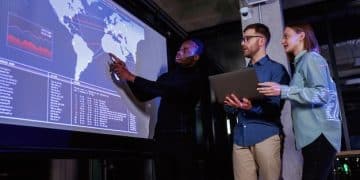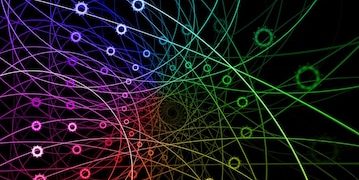AI and Automation Reshaping US Jobs: The Future of Work

Artificial intelligence and automation are fundamentally transforming the US job market, necessitating adaptability and new skill acquisition among the workforce to thrive in an evolving economic landscape.
The landscape of employment in the United States is always in flux, but few forces promise to reshape it as profoundly as artificial intelligence (AI) and automation. As these technologies mature and integrate more deeply into industries, understanding their trajectory becomes paramount for workers, businesses, and policymakers alike. This exploration delves into The Future of Work: How AI and Automation are Reshaping US Jobs, dissecting the intricate dance between innovation and human labor.
The AI and Automation Revolution: A New Dawn for Labor
The advent of artificial intelligence and automation is not merely an incremental technological advancement; it represents a seismic shift, akin to past industrial revolutions, that is fundamentally altering how work is performed, where it takes place, and the very nature of jobs. This revolution, driven by increasingly sophisticated algorithms and robotic systems, promises to redefine productivity, efficiency, and the division of labor between humans and machines.
The rapid progress in machine learning, deep neural networks, and robotic capabilities is enabling machines to perform tasks once thought exclusive to human cognition. From complex data analysis and pattern recognition to repetitive physical tasks, AI and automation are demonstrating capabilities that were unimaginable just a decade ago. This has profound implications for every sector of the US economy, from manufacturing and logistics to healthcare and finance.
While the immediate impact often conjures images of job displacement, a more nuanced understanding reveals a complex interplay of destruction and creation. Certain jobs, particularly those involving highly repetitive or predictable tasks, are indeed vulnerable to automation. However, new roles are simultaneously emerging, often requiring skills that complement AI technologies rather than compete with them. This creates a dynamic environment where continuous learning and adaptation become vital for workforce resilience.
Defining the Core Technologies
Understanding the impact of this revolution requires a clear grasp of the core technologies propelling it. Artificial intelligence encompasses a broad range of computer science that enables machines to perform tasks typically requiring human intelligence. Automation, on the other hand, deals with creating technology and processes to perform tasks with minimal human intervention.
These two concepts often intertwine, with AI powering more intelligent and adaptive automation systems. Key components include:
- Machine Learning: Algorithms that allow systems to learn from data without explicit programming, enabling predictive analytics and pattern recognition.
- Robotics: Physical or virtual machines designed to perform specific tasks, ranging from industrial arms to software bots.
- Natural Language Processing (NLP): Gives computers the ability to understand, interpret, and generate human language, crucial for customer service and content creation.
- Computer Vision: Enables computers to “see” and interpret visual information, vital for autonomous vehicles and quality control.
The integration of these technologies is not uniformly distributed across industries, but their pervasive influence is steadily expanding. Companies are investing heavily in AI and automation to enhance operational efficiency, reduce costs, and gain competitive advantages. This investment drives further innovation, creating a positive feedback loop that accelerates the pace of change across the US job market. Furthermore, the accessibility of AI tools, particularly for small and medium-sized businesses, is democratizing these technologies, allowing even smaller enterprises to leverage their power. This broad adoption is what truly distinguishes the current technological wave from previous ones, ensuring its widespread impact.
Job Displacement and Creation: Navigating the Evolving Landscape
The most immediate and often controversial concern surrounding AI and automation is their potential impact on employment levels. While some argue for mass unemployment, a more measured perspective suggests a significant transformation of existing roles and the emergence of entirely new ones. The reality is likely to be a complex mosaic of job losses in certain sectors, coupled with gains in others, ultimately leading to a shift in the nature of work.
History offers insights into how technological revolutions have reshaped labor markets. The agricultural and industrial revolutions, for instance, drastically reduced the need for manual labor in farming and manufacturing, respectively, but simultaneously sparked the growth of new industries and professions. Similarly, AI and automation are expected to automate routine, repetitive, and predictable tasks, freeing human workers to focus on activities requiring creativity, critical thinking, emotional intelligence, and complex problem-solving. This reallocation of human effort from the mundane to the innovative holds the key to future job creation.
Sectors at the Forefront of Change
Different sectors will experience AI and automation in distinct ways. Manufacturing, long a bastion of automation, will see further integration of robotic systems, enhancing precision and speed while possibly reducing manual assembly line jobs. The transportation sector is poised for disruption with autonomous vehicles, impacting roles for drivers. In the service industry, customer service, data entry, and even some administrative roles are increasingly being handled by AI-powered chatbots and software.
Conversely, some sectors are expected to see significant growth fueled by AI. Technology development, data science, AI ethics, and cybersecurity are expanding rapidly. Furthermore, roles that involve direct human interaction, personalized services, or complex strategic planning are less susceptible to automation and may even see increased demand as these technologies handle the more routine aspects of their jobs. The demand for creative professionals, researchers, and educators is also expected to rise, as these fields require uniquely human capacities that AI cannot replicate. Ultimately, the future workforce will need a heightened focus on skills that are inherently human.
The challenge lies in managing this transition. Policymakers, educators, and businesses face the critical task of preparing the workforce for these shifts. Investment in reskilling and upskilling programs is paramount to ensure that displaced workers can transition into new roles and that the emerging demand for AI-related skills can be met. Without proactive measures, the benefits of AI and automation may not be equitably distributed, potentially exacerbating social and economic inequalities.
The Rise of New Skills: What the Future Workforce Needs
As AI and automation take on more routine and predictable tasks, the demand for traditional, task-specific skills will inevitably wane for some roles. Instead, the future workforce will increasingly require a new set of capabilities that complement intelligent machines, emphasizing human strengths that AI cannot replicate. This shift necessitates a profound re-evaluation of educational systems and corporate training programs to align with emerging labor market demands. The focus will move from “what you know” to “how you learn and adapt.”
The skills most valuable in an AI-driven economy will be those that foster innovation, critical thinking, complex problem-solving, and interpersonal effectiveness. These are often referred to as “soft skills,” but their importance is far from soft; they are the bedrock of human-machine collaboration and creative endeavors. Moreover, a foundational understanding of AI and data literacy will become increasingly crucial, even for roles not directly involved in AI development, as workers will need to interact with and leverage AI tools in various capacities.
Key Competencies for the Future
Several categories of skills will be critical for success in the evolving job market:
- Cognitive Flexibility and Adaptability: The ability to learn new concepts quickly, unlearn outdated approaches, and adapt to rapidly changing work environments.
- Creativity and Innovation: Focusing on generating novel ideas, products, and solutions, leveraging AI as a tool rather than a replacement.
- Critical Thinking and Complex Problem-Solving: Analyzing intricate situations, identifying core issues, and developing strategic solutions that go beyond algorithmic responses.
- Emotional Intelligence and Collaboration: Essential for teamwork, leadership, negotiation, and understanding human needs in a service-oriented economy.
- Digital Literacy and Data Fluency: A basic understanding of how AI works, data interpretation, and using digital tools effectively.
Beyond these broad categories, sector-specific advanced technical skills related to AI development, maintenance, and ethical governance will also be in high demand. These include AI engineers, data scientists, machine learning specialists, AI ethicists, and robotics technicians. The blend of human-centric skills and targeted technical expertise will define the most competitive candidates in the years to come.
Reskilling and upskilling initiatives, both within companies and through public education systems, are vital for ensuring a smooth transition. Lifelong learning will cease to be a concept and become a fundamental necessity. Governments, educational institutions, and businesses must collaborate to create accessible and effective pathways for workers to acquire these new competencies, ensuring that the benefits of AI-driven productivity gains are widely shared across the workforce. This will not only improve individual career prospects but also strengthen the overall economic resilience of the US.

Economic Implications: Productivity, Inequality, and Growth
The widespread adoption of AI and automation carries significant economic implications for the United States, extending beyond individual job impacts to encompass national productivity, income distribution, and overall economic growth. On one hand, these technologies hold the promise of unprecedented productivity gains, driving economic expansion and enhancing global competitiveness. On the other, they present challenges related to widening income inequality and the need for robust policy responses to ensure equitable benefits.
Increased automation in manufacturing, logistics, and services can lead to substantial efficiency improvements, reduced operational costs, and higher output. AI’s ability to analyze vast datasets can unlock new insights, optimize complex processes, and accelerate innovation across industries. If these productivity gains are effectively leveraged, they could lead to higher living standards, increased investment, and a stronger US economy on the global stage. This long-term growth potential is a primary driver behind the rapid adoption of AI technologies.
However, the distribution of these benefits is a critical concern. If the gains from AI and automation disproportionately accrue to capital owners and highly-skilled workers who design and manage these systems, it could exacerbate existing income disparities. Workers whose tasks are automated away, particularly those with limited access to retraining opportunities, risk being left behind. This could lead to social unrest and political instability, underscoring the urgency for proactive policy interventions. The economic implications are not merely theoretical; they are already beginning to manifest in shifts in labor demand and wage structures.
Addressing Potential Disparities
Mitigating the negative economic impacts and ensuring a more equitable distribution of benefits requires a multi-pronged policy approach. This includes:
- Investment in Education and Training: Robust government and private sector initiatives for reskilling and upskilling the workforce, particularly for those in vulnerable occupations.
- Portable Benefits and Social Safety Nets: Exploring models like universal basic income (UBI) or expanded unemployment benefits to provide a safety net for workers in transition.
- Tax and Regulatory Frameworks: Reevaluating tax systems to encourage human investment and potentially taxing highly automated capital to fund public services.
- Promoting Entrepreneurship: Fostering an environment where new businesses can emerge from AI technologies, creating new jobs and opportunities.
Ultimately, the economic outcome will depend on how society chooses to manage this technological transition. A proactive, adaptive, and inclusive approach can harness the immense potential of AI and automation for broad-based prosperity. Conversely, a passive or reactive stance risks magnifying existing social and economic inequalities. The current economic trajectory, if left unchecked, could lead to a two-tiered economy, necessitating urgent and thoughtful policymaking.
Ethical and Societal Considerations: Beyond the Algorithm
The profound capabilities of AI and automation extend beyond mere economic and employment shifts, raising complex ethical and societal questions that demand careful consideration and proactive governance. As these technologies become more pervasive, their impact on privacy, bias, accountability, and the very fabric of society becomes increasingly significant. Navigating this new frontier requires more than technological prowess; it demands a robust ethical framework.
One of the foremost concerns is the issue of algorithmic bias. AI systems learn from data, and if that data reflects existing societal biases (e.g., in hiring, lending, or criminal justice), the AI will perpetuate and even amplify those biases. This can lead to unfair outcomes, discriminate against minority groups, and erode public trust in autonomous systems. Ensuring fairness, transparency, and accountability in AI development is paramount to prevent exacerbating existing social inequalities. Furthermore, the use of AI in surveillance and data collection raises significant privacy concerns, requiring clear regulations on data usage and protection.
The increasing autonomy of AI systems also poses questions of accountability. When an AI system makes a mistake or causes harm, who is responsible? Is it the developer, the deployer, or the AI itself? Establishing clear legal and ethical frameworks for AI accountability is essential, particularly in critical applications like autonomous vehicles or medical diagnoses. Beyond these immediate concerns, there are broader societal implications, such as the potential impact on human agency, decision-making, and the nature of human connection in an increasingly automated world.
Addressing the Broader Impact
Grappling with these ethical and societal challenges requires a multi-faceted approach:
- Ethical AI Development: Promoting “ethics by design” principles, where ethical considerations are integrated from the initial stages of AI development.
- Regulation and Governance: Developing clear, adaptive regulations that balance innovation with protection against harm, fostering responsible AI use.
- Public Education and Engagement: Raising public awareness about AI’s capabilities and limitations, and involving diverse stakeholders in policy discussions.
- Protecting Data Privacy: Implementing strong data protection laws and ensuring transparency in how personal data is collected and used by AI systems.
- Promoting Digital Inclusion: Ensuring equitable access to AI benefits and preventing a digital divide where some communities are left out.
The debate around ethical AI is not merely academic; it has real-world consequences for individuals and society at large. A thoughtful and collaborative approach, involving technologists, policymakers, ethicists, and the public, is essential to shape an AI-powered future that is not only productive but also equitable, just, and human-centric. The decisions made today will significantly influence the moral compass of future technological advancements.
Policy Responses and Future Strategies: Shaping the Transition
The transformative power of AI and automation demands a proactive and comprehensive set of policy responses to ensure that the United States harnesses its benefits while mitigating its risks. A hands-off approach could lead to significant social dislocation and economic inequality. Instead, governments, in collaboration with the private sector, academia, and civil society, must develop strategic frameworks that guide this transition responsibly. These strategies should encompass not just economic measures but also educational, ethical, and regulatory considerations.
Effective policy must be forward-looking and adaptable, recognizing that the pace of technological change is accelerating. It must avoid stifling innovation while simultaneously establishing guardrails that protect workers and citizens. The goal is to maximize the opportunities created by AI—such as increased productivity, new industries, and improved quality of life—while minimizing adverse impacts like job displacement, widening inequality, and ethical missteps. This requires a delicate balance and a willingness to experiment with new policy models.
One critical area for policy intervention is education and workforce development. Governments can invest in public education systems to align curricula with future skill demands, from foundational digital literacy to advanced AI expertise. They can also fund and incentivize robust reskilling and upskilling programs for adult workers, ensuring smooth transitions for those in occupations vulnerable to automation. This includes encouraging lifelong learning through apprenticeships, vocational training, and online courses.
Key Policy Levers
A range of policy levers can be utilized to shape the future of work:
- Investment in R&D: Continued government funding for AI research and development, particularly in areas like ethical AI, explainable AI, and AI for societal good.
- Infrastructure Development: Investing in digital infrastructure, including high-speed internet access across all regions, to ensure equitable participation in the digital economy.
- Regulatory Sandboxes: Creating environments where new AI technologies can be tested and evaluated in a controlled setting, allowing for adaptive regulation.
- Data Governance Frameworks: Establishing clear rules for data collection, usage, and privacy to build trust in AI systems.
- Social Safety Net Enhancements: Exploring reforms to unemployment insurance, healthcare, and other social programs to provide a stronger safety net in a more volatile labor market.
Beyond these, fostering public-private partnerships is crucial. Collaboration between government, industry, and academia can accelerate research, streamline talent development, and inform effective policymaking. International cooperation is also vital as AI is a global phenomenon, and shared standards and approaches can prevent a fragmented regulatory landscape. The policies implemented today will determine whether the AI revolution becomes a source of broad prosperity or increased societal division. This is a crucial window for strategic planning and action to ensure a future where technology serves all.

The Human Element: Adaptability, Resilience, and Creativity
Amidst the profound shifts brought by AI and automation, it is crucial to remember that the human element remains at the core of the future of work. While machines excel at processing information, executing repetitive tasks, and optimizing complex systems, uniquely human attributes—adaptability, resilience, creativity, and emotional intelligence—will become even more valuable. The new era of work is not about humans versus machines, but rather humans working alongside intelligent tools, augmenting our capabilities and freeing us to pursue higher-order tasks.
Adaptability will be key. The notion of a static career path, where one acquires a set of skills early in life and uses them for decades, is becoming obsolete. Instead, continuous learning and the ability to pivot to new roles and responsibilities will be essential. This requires a mindset of lifelong learning and a willingness to embrace change, seeing new technologies not as threats but as opportunities for growth and evolution. Workers who cultivate this flexibility will be better positioned to thrive in dynamic environments.
Resilience, both personal and collective, will also be paramount. The transition won’t always be smooth, and some workers will face significant challenges. Fostering psychological resilience—the capacity to recover quickly from difficulties—will be crucial for individuals. At a societal level, building economic resilience through robust social safety nets and accessible retraining programs will help communities navigate disruptive changes. This human capacity to persevere through adversity is what will ultimately facilitate a successful transition.
Cultivating Core Human Strengths
The future of work places a premium on our distinctly human strengths:
- Empathy and Emotional Intelligence: Essential for roles involving human interaction, customer service, healthcare, and leadership, where understanding and responding to human emotions is critical.
- Creativity and Innovation: The ability to imagine new possibilities, develop novel solutions, and create original content, areas where AI can assist but not originate.
- Critical Thinking and Judgment: Evaluating complex situations, making nuanced decisions, and applying ethical reasoning – skills beyond current AI capabilities.
These human attributes are not automatically developed; they require nurturing through education, experience, and societal values. Investing in education that fosters these skills, from early childhood through adult learning, is perhaps the most strategic long-term investment a society can make in an AI-driven world. Furthermore, fostering environments that encourage curiosity, experimentation, and interdisciplinary collaboration will be vital for cultivating the next generation of innovators. The future of work, therefore, is not about becoming more like machines, but about becoming more profoundly human. Our capacity to connect, imagine, and reason will define our value in a world increasingly powered by artificial intelligence.
Transformative Industries: AI’s Sectoral Impact and Opportunity
Artificial intelligence and automation are not impacting all industries uniformly; rather, they are catalyzing sector-specific transformations, creating unique opportunities and challenges within each domain. Understanding these nuanced impacts is crucial for businesses aiming to stay competitive and for workers seeking to navigate career paths in a rapidly evolving economy. Certain industries, due to their nature of work and data intensity, are at the forefront of this industrial metamorphosis.
The financial sector, for instance, is seeing AI revolutionize everything from fraud detection and algorithmic trading to personalized financial advice and credit scoring. AI’s ability to process vast amounts of financial data at high speed allows for real-time risk assessment and more precise market predictions. While some roles in routine data processing may be automated, new high-value roles are emerging in AI strategy, ethical finance, and complex financial analysis. This transformation promises greater efficiency and more sophisticated services for consumers.
Healthcare is another industry poised for profound change. AI is aiding in drug discovery, diagnostic imaging analysis, personalized treatment plans, and even robotic surgery. The ability of AI to analyze medical records and diagnostic images with incredible precision can lead to early disease detection and more effective treatments. While AI won’t replace doctors, it will augment their capabilities, freeing them to focus on complex patient care and empathetic interactions. This shift enhances both the quality and accessibility of healthcare services across the US.
Sector-Specific Opportunities and Challenges
Examining key sectors reveals diverse impacts:
- Manufacturing: Enhanced by smart factories, predictive maintenance, and robotic automation, leading to higher efficiency but demanding a workforce skilled in robotics and data analytics.
- Retail and E-commerce: AI drives personalized recommendations, optimized supply chains, and automated customer service, creating demand for data scientists and UX designers.
- Education: AI can personalize learning experiences, automate grading, and provide data-driven insights for educators, requiring a shift in teaching methodologies and digital literacy among teachers.
- Agriculture: Precision farming, automated harvesting, and drone-based monitoring powered by AI can increase yields and sustainability, creating roles in agri-tech and data analysis.
Each industry’s journey with AI and automation will be unique, shaped by its specific operational needs, regulatory environments, and workforce demographics. Businesses that strategically embrace these technologies, invest in employee training, and adapt their business models will gain significant competitive advantages. Simultaneously, workers who understand how AI is reshaping their specific industry and proactively acquire relevant skills will be best equipped to seize emerging opportunities. This sectoral lens highlights that the future of work is not a monolithic concept but a diverse tapestry of transformation across the American economy.
| Key Aspect | Brief Description |
|---|---|
| 🔄 Job Transformation | AI automates routine tasks, shifting demand towards creative, critical thinking, and interpersonal skills. |
| 🧠 New Skill Needs | Emphasis on adaptability, emotional intelligence, advanced problem-solving, and digital literacy. |
| 💰 Economic Impact | Potential for increased productivity but also risk of widening inequality without proactive policies. |
| ⚖️ Ethical Challenges | Concerns about algorithmic bias, privacy, and accountability require robust governance frameworks. |
Frequently Asked Questions About AI and the Future of Work
▼
While AI and automation will displace jobs performing repetitive tasks, experts generally predict job transformation rather than mass unemployment. New jobs will emerge, requiring different skills that complement AI, leading to a shift in the nature of work rather than its complete disappearance. Adapting to this change is key for the workforce; continuous learning will be crucial.
▼
Future jobs will prioritize uniquely human skills such as critical thinking, creative problem-solving, emotional intelligence, adaptability, and complex communication. Digital literacy, data fluency, and a basic understanding of AI will also be increasingly important across various sectors. These skills enable humans to collaborate effectively with AI systems and innovate.
▼
Preparation involves prioritizing lifelong learning through reskilling and upskilling programs offered by employers, educational institutions, and government initiatives. Focusing on developing soft skills, digital literacy, and understanding AI’s practical applications in one’s field will enhance employability and adaptability to new roles. Proactive engagement with new technologies is vital.
▼
Yes, significant ethical concerns include algorithmic bias, which can perpetuate discrimination in hiring or decision-making, and privacy issues related to data collection. Questions of accountability for AI-driven decisions and ensuring equitable access to technology’s benefits also arise, necessitating robust ethical guidelines and regulatory frameworks for AI development and deployment.
▼
Government policies are crucial for managing the transition by investing in education and retraining programs, updating social safety nets, fostering innovation, and developing ethical AI guidelines. They can help ensure a just transition for workers, mitigate income inequality, and promote equitable access to job opportunities created by technological advancements, shaping a beneficial future.
Conclusion
The profound impact of artificial intelligence and automation on the US job market is an undeniable reality, marking a pivotal moment in the evolution of work. While these transformative technologies present genuine challenges, particularly concerning job displacement and potential inequality, they also herald an era of unprecedented productivity gains, the creation of entirely new industries, and enhanced human capabilities. Navigating this complex landscape effectively hinges on a collective commitment to adaptability, continuous learning, and proactive policy development. By fostering uniquely human skills like creativity and critical thinking, investing heavily in education and reskilling initiatives, and establishing robust ethical and regulatory frameworks, the United States can ensure that the future of work is not defined by fear but by opportunity, growth, and broad-based prosperity for all its citizens.





